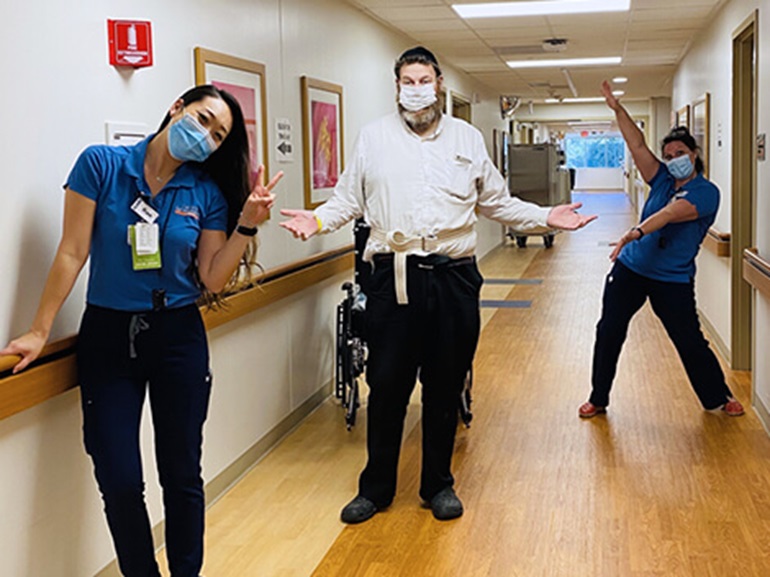Alan's Story

In mid-March, Alan Cooper, a 48-year-old Los Angeles tax attorney, started feeling ill. The married father of three and grandfather of two had developed a fever and, when it didn’t subside after several days, he went to urgent care. There, a lung scan showed significant inflammation. Suspecting he may have COVID-19, Alan was sent to the Cedars-Sinai Emergency Department, where his wife is a physician.
Alan was placed on supplemental oxygen and testing confirmed COVID-19 diagnosis. His condition declined, and he was ultimately placed on a ventilator for four weeks. To his family’s relief, Alan stabilized, but was weak from his viral battle. His wife had “heard great things about California Rehabilitation Institute” and felt this was the place to be,” Alan said.
When he arrived at Cal Rehab at the end of April, Alan was unable to sit, stand or walk on his own. He had trouble swallowing, numbness in both hands and poor muscle tone in his feet. His entire right side was weak and he was blind in his right eye. Alan’s goal was to return to full independence. He wanted to walk, get back to work and play with his grandchildren.
A physician-led team of nurses, therapists and other rehabilitation specialists created a plan to help Alan get there. Physical therapists crafted a full-body strength training program. They placed him on a recumbent exercise bike to get his blood pumping for a low-impact cardiovascular workout. He also performed a range of exercises, including heel raises, mini squats, bed bridges and hamstring curls, as well as activities to improve his balance, such as tossing and catching a balloon.
Therapists also helped Alan practice standing and walking with a walker. A key turning point came when he was able to walk outside of his room. It helped give him a sense of freedom he hadn’t felt since before being diagnosed with COVID-19.
Occupational therapists focused on restoring strength and dexterity to his right hand and the right side of his body. In addition to traditional therapeutic exercises, Alan participated in fun activities such as beading necklaces for his granddaughter, picking up nuts and bolts and playing Jenga.
Due to COVID-19 safety precautions, Alan’s family was unable to visit him while at Cal Rehab, but he had nightly video chats with them so they could offer encouragement and support. The hospital’s team arranged a couple of wellness visits with members of his family so they could visit him.
After over four weeks, Alan was ready to go home. He plans to continue his therapy exercises and is looking forward to seeing his family in person. Rehab, Alan said, is not a quick fix, but is worth it. "Progress is slow and, sometimes, you regress a bit,” he added. “Generally, any improvement is a step forward. Patience is key. I was itching to go home, but I knew I had to get my work done here first.”
Alan’s advice for those just starting on their rehabilitation journey is to stay focused on long-term goals. “Just keep visualizing how you want to be at the end,” he said.